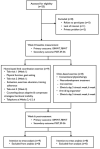Home-based rehabilitation programs on postural balance, walking, and quality of life in patients with stroke: A single-blind, randomized controlled trial
- PMID: 34477171
- PMCID: PMC8415945
- DOI: 10.1097/MD.0000000000027154
Home-based rehabilitation programs on postural balance, walking, and quality of life in patients with stroke: A single-blind, randomized controlled trial
Abstract
Background: The most challenging aspect of rehabilitation is the high costs of in-patient rehabilitation programs and poor continuity of care while patients are transferred to home. In this regard, numerous home-based rehabilitation programs have been developed. The purpose of this study was to investigate the effects of home-based rehabilitative programs on postural balance, walking, and quality of life in individuals with chronic hemiparetic stroke.
Design: A CONSORT-compliant randomized controlled trial.
Methods: Seventeen community-dwelling people diagnosed with a first stroke participated in this study. They randomly divided the home-based rehabilitative program (HBP) group (n = 9) and control group (n = 8). The HBP group received coordination exercises at home and the control group received clinic-based exercises. This study measured postural balance, walking, and quality of life using four outcome measures: 10-meter walk test, figure of 8 walk test, four-square step test, and 36 item short-form survey.
Results: After analysis, it was found that the HBP improved postural balance, comfortable speed, and fast speed walking, and straight and curved walking for chronic stroke. Second, clinic-based rehabilitation services improved postural balance, comfortable speed, and fast speed walking abilities in patients with chronic stroke.
Conclusion: The results of this study suggest that the HBP group received positive benefits with regard to the postural balance and walking abilities of chronic hemiparetic stroke patients compared to the clinical setting exercise program.
Copyright © 2021 the Author(s). Published by Wolters Kluwer Health, Inc.
Conflict of interest statement
The authors have no conflict of interest to disclose.
Figures
References
-
- Feigin, Feigin VL, Lawes CM, Bennett DA, Barker-Collo SL, Parag V. Worldwide stroke incidence and early case fatality reported in 56 population-based studies: a systematic review. Lancet Neurol 2009;8:355–69. - PubMed
-
- Nor Azlin MN, Aziz NA, Saperi BS, Aljunid SM. Functional limitation and health-related quality of life, and associated factors among long term stroke survivors in a Malaysian community. Med J Malaysia 2016;71:313–21. - PubMed
-
- Mayo NE. Stroke rehabilitation at home. Stroke 2016;47:1685–91. - PubMed
-
- Peirone E, Goria PF, Anselmino A. A dual-task home-based rehabilitation programme for improving balance control in patients with acquired brain injury: a single-blind, randomized controlled pilot study. Clin Rehabil 2014;28:329–38. - PubMed
Publication types
MeSH terms
LinkOut - more resources
Full Text Sources
Medical
Miscellaneous


